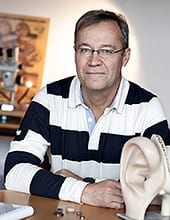Functionally deaf patients can gain normal hearing with a new implant that replaces the middle ear.
The unique invention from the Chalmers University of Technology has been approved for a clinical study. The first operation was performed on a patient in December 2012.
“You hear 50 percent of your own voice through bone conduction, so you perceive this sound as quite natural”, says Professor Bo Håkansson, of the Department of Signals and Systems, Chalmers.
The new implant, BCI (Bone Conduction Implant), was developed by Bo Håkansson and his team of researchers. Unlike the type of bone-conduction device used today, the new hearing implant does not need to be anchored in the skull bone using a titanium screw through the skin. The patient has no need to fear losing the screw and there is no risk of skin infections arising around the fixing.
The first operation was performed on 5 December 2012 by Måns Eeg-Olofsson, Senior Physician at Sahlgrenska University Hospital, Gothenburg, and went entirely according to plan.
“Once the implant was in place, we tested its function and everything seems to be working as intended so far. Now, the wound needs to heal for six weeks before we can turn the hearing sound processor on”, says Måns Eeg-Olofsson, who has been in charge of the medical aspects of the project for the past two years.
The technique has been designed to treat mechanical hearing loss in individuals who have been affected by chronic inflammation of the outer or middle ear, or bone disease, or who have congenital malformations of the outer ear, auditory canal or middle ear. Such people often have major problems with their hearing. Normal hearing aids, which compensate for neurological problems in the inner ear, rarely work for them. On the other hand, bone-anchored devices often provide a dramatic improvement.
In addition, the new device may also help people with impaired inner ear.
“Patients can probably have a neural impairment of down to 30-40 dB even in the cochlea. We are going to try to establish how much of an impairment can be tolerated through this clinical study”, says Bo Håkansson.










